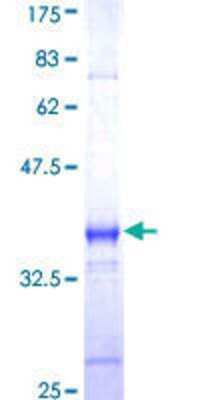PAR4 Products
PAR4, also known as F2RL3 and Coagulation Factor II (Thrombin) Receptor-like 3, is a member of the Protease-activated Receptor (PAR) family of seven transmembrane G protein-coupled receptors that are activated by proteolysis. It is 385 amino acids (aa) in length with a predicted molecular weight of 41.1 kDa. Human PAR4 shares 78% aa sequence identity with the mouse ortholog. PAR4 is widely expressed with highest expression levels being found in the lungs, pancreas, thyroid, testis, and small intestine. It is also observed in platelets, megakaryocytes, and leukocytes. PAR4 is activated by Thrombin, Trypsin, and Cathepsin G. These proteases bind to and cleave the N-terminal extracellular domain of PAR4 to generate a new N-terminus. This new N-terminus then functions as a tethered peptide ligand that binds to and activates the receptor. PAR4 is coupled to G proteins containing the alphaq and alpha12/13 subunits and has been shown to activate the PLC-IP3-Ca2+ and PLC-DAG-PKC signal transduction pathways. PAR4 plays an essential role in hemostasis and thrombosis. Interestingly, PAR4 requires PAR3 as a cofactor to achieve optimal Thrombin-induced platelet activation. PAR4 has also been suggested to be involved in regulation of gastrointestinal motility, modulation of nociceptive responses, and stimulation of epithelial to mesenchymal transition in alveolar epithelial cells. Down-regulation of PAR4 expression occurs frequently in gastric cancers and is associated with an aggressive progression of gastric cancer.
11 results for "PAR4" in Products
11 results for "PAR4" in Products
PAR4 Products
PAR4, also known as F2RL3 and Coagulation Factor II (Thrombin) Receptor-like 3, is a member of the Protease-activated Receptor (PAR) family of seven transmembrane G protein-coupled receptors that are activated by proteolysis. It is 385 amino acids (aa) in length with a predicted molecular weight of 41.1 kDa. Human PAR4 shares 78% aa sequence identity with the mouse ortholog. PAR4 is widely expressed with highest expression levels being found in the lungs, pancreas, thyroid, testis, and small intestine. It is also observed in platelets, megakaryocytes, and leukocytes. PAR4 is activated by Thrombin, Trypsin, and Cathepsin G. These proteases bind to and cleave the N-terminal extracellular domain of PAR4 to generate a new N-terminus. This new N-terminus then functions as a tethered peptide ligand that binds to and activates the receptor. PAR4 is coupled to G proteins containing the alphaq and alpha12/13 subunits and has been shown to activate the PLC-IP3-Ca2+ and PLC-DAG-PKC signal transduction pathways. PAR4 plays an essential role in hemostasis and thrombosis. Interestingly, PAR4 requires PAR3 as a cofactor to achieve optimal Thrombin-induced platelet activation. PAR4 has also been suggested to be involved in regulation of gastrointestinal motility, modulation of nociceptive responses, and stimulation of epithelial to mesenchymal transition in alveolar epithelial cells. Down-regulation of PAR4 expression occurs frequently in gastric cancers and is associated with an aggressive progression of gastric cancer.
| Reactivity: | Human |
| Details: | Rabbit IgG Polyclonal |
| Applications: | IHC |
| Reactivity: | Human |
| Details: | Rabbit IgG Polyclonal |
| Applications: | WB, ICC/IF |
| Reactivity: | Human |
| Details: | Mouse IgG1 kappa Monoclonal Clone #5F4 |
| Applications: | WB, ELISA, Flow |
| Applications: | WB, ELISA, MA, AP |
| Reactivity: | Human |
| Details: | Rabbit IgG Polyclonal |
| Applications: | IHC |
| Applications: | ELISA |
| Applications: | WB |
| Applications: | AC |
Selective PAR4 agonist
| Alternate Names: | AYPGKF-NH2 |
| Purity: | ≥95% (HPLC) |


![Immunohistochemistry-Paraffin: PAR4 Antibody - BSA Free [NLS1308] Immunohistochemistry-Paraffin: PAR4 Antibody - BSA Free [NLS1308]](https://resources.bio-techne.com/images/products/PAR4-Antibody-Immunohistochemistry-Paraffin-NLS1308-img0001.jpg)
![Western Blot: PAR4 Antibody [NBP3-21255] - Western Blot: PAR4 Antibody [NBP3-21255] -](https://resources.bio-techne.com/images/products/nbp3-21255_rabbit-par4-pab-45202315493266.jpg)
![ELISA: PAR4 Antibody (5F4) [H00009002-M01] ELISA: PAR4 Antibody (5F4) [H00009002-M01]](https://resources.bio-techne.com/images/products/PAR4-Antibody-5F4-ELISA-H00009002-M01-img0003.jpg)

![Immunohistochemistry-Paraffin: PAR4 Antibody - BSA Free [NLS1311] Immunohistochemistry-Paraffin: PAR4 Antibody - BSA Free [NLS1311]](https://resources.bio-techne.com/images/products/PAR4-Antibody-Immunohistochemistry-Paraffin-NLS1311-img0001.jpg)
![ELISA: Human PAR4 ELISA Kit (Colorimetric) [NBP3-06971] - Human PAR4 ELISA Kit (Colorimetric)](https://resources.bio-techne.com/images/products/nbp3-06971_human-par4-elisa-kit-colorimetric-132202416251795.jpg)
![Western Blot: PAR4 Overexpression Lysate [NBL1-10411] Western Blot: PAR4 Overexpression Lysate [NBL1-10411]](https://resources.bio-techne.com/images/products/Proteinase-activated-receptor-4-PAR4-Overexpression-Lysate-Adult-Normal-Western-Blot-NBL1-10411-img0002.jpg)

